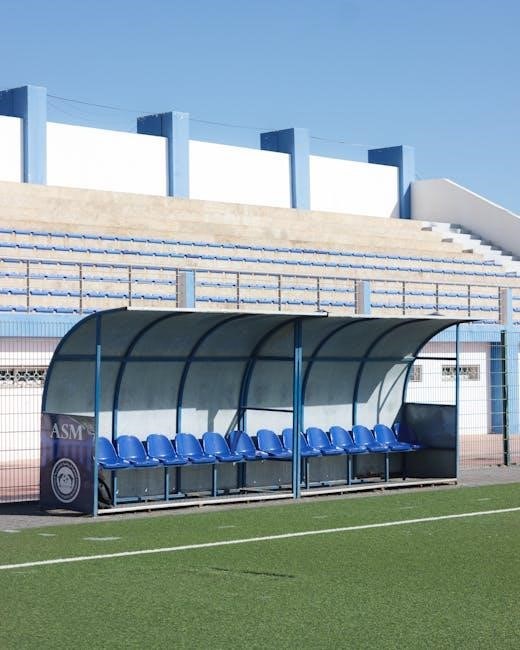ASME B16.5 is a standard for pipe flanges and flanged fittings, covering dimensions, materials, and pressure-temperature ratings. It applies to NPS 1/2 through NPS 24 sizes, ensuring dimensional accuracy and safety in industrial applications.
What is ASME B16.5?
ASME B16.5 is a standard for pipe flanges and flanged fittings, detailing dimensions, materials, and pressure-temperature ratings. It applies to NPS 1/2 through NPS 24, covering various flange types like weld neck, slip-on, and threaded designs. The standard ensures safety and reliability in industrial piping systems by specifying material grades, testing, and certification requirements.
Publication and Revision History
ASME B16.5 was first published in 1964 and has undergone several revisions to reflect advancements in technology and industry needs. The latest revision, ASME B16.5-2020, updates the 2017 edition, incorporating new materials and improved testing methods. Regular updates ensure the standard remains relevant, addressing safety, reliability, and performance in piping systems across various industries.
Purpose and Importance
ASME B16.5 provides standardized specifications for pipe flanges and flanged fittings, ensuring consistency and reliability in industrial piping systems. Its purpose is to define dimensions, materials, and pressure-temperature ratings, enhancing safety and interchangeability. This standard is crucial for maintaining integrity and performance in oil, gas, and other industries, where flanges are critical components.

Scope and Application
ASME B16.5 applies to pipe flanges and flanged fittings from NPS 1/2 to NPS 24, covering dimensions, materials, and ratings for industrial piping systems.
Size Range (NPS 1/2 to NPS 24)
ASME B16.5 specifies dimensions for pipe flanges and flanged fittings from NPS 1/2 to NPS 24, ensuring compatibility and safety in industrial piping systems. This range accommodates various applications, providing standardized solutions for different pressure and temperature requirements across industries.
Technical Parameters and Requirements
ASME B16.5 outlines specific technical parameters, including pressure-temperature ratings, material compliance, and dimensional tolerances. It ensures flanges and fittings meet rigorous safety and performance standards. The standard also covers requirements for testing, certification, and marking, guaranteeing reliability in industrial piping systems. Adherence to these parameters is critical for maintaining integrity under various operating conditions.

Material Specifications
ASME B16.5 specifies material grades, classifications, and manufacturing processes for flanges and fittings, ensuring compliance with pressure and temperature requirements in industrial applications.
Material Grades and Classification
ASME B16.5 classifies materials into grades based on mechanical properties and chemical composition. Common grades include carbon steel, stainless steel, and alloy steel. The standard specifies requirements for material selection, ensuring suitability for pressure-temperature ratings. Compliance with these classifications guarantees safety and reliability in industrial piping systems.
Testing and Certification Requirements
ASME B16.5 requires rigorous testing, including tensile, impact, and hydrostatic tests, to ensure material integrity. Certification involves third-party inspection and documentation, verifying compliance with standard specifications. These requirements guarantee reliability and safety in industrial applications, ensuring flanges meet design and performance criteria.

Types of Flanges
ASME B16.5 specifies several flange types, including Weld Neck, Slip-On, Socket Weld, and Threaded flanges, each designed for specific piping applications and connection requirements.
Weld Neck Flanges
Weld Neck Flanges, defined in ASME B16.5, feature a long tapered hub for high strength and resistance to stress. Ideal for critical applications, they are welded directly to pipe ends, ensuring a strong, leak-resistant connection. Commonly used in high-pressure and high-temperature systems, these flanges are available in various material grades and comply with standard dimensional and pressure-temperature ratings, making them versatile for industrial piping needs.
Slip-On Flanges
Slip-On Flanges, as per ASME B16.5, are designed with a flat face and a rounded hub. They slide over the pipe end, secured by welding both inside and outside. These flanges are cost-effective and easier to install, suitable for low to moderate pressure applications. Available in various materials, they meet standard dimensional and pressure-temperature requirements, offering reliability in diverse industrial piping systems while ensuring efficient performance and durability in operations.
Socket Weld Flanges
Socket Weld Flanges, specified in ASME B16.5, feature a socket where the pipe fits, secured by a single fillet weld. These flanges are ideal for small pipe sizes, offering good strength and resistance to leakage. They are commonly used in high-pressure, high-temperature applications where strength and durability are critical, ensuring reliable performance in demanding industrial environments while adhering to standard specifications and safety requirements.
Threaded Flanges
Threaded Flanges, as per ASME B16.5, are designed with tapered threads for easy installation without welding. They are ideal for low-pressure applications and smaller pipe sizes. Available in various material grades and pressure classes (e.g., 150#, 300#), these flanges are cost-effective and suitable for systems where welding is not feasible. Their tapered threads ensure a tight seal, making them reliable for preventing leakage in industrial piping systems.

Dimensional Requirements
ASME B16.5 specifies standard dimensions for flanges and fittings, ensuring compatibility and proper fit-up across NPS 1/2 to 24 sizes, critical for safe and reliable piping systems.
Standard Dimensions and Tolerances
ASME B16.5 provides precise dimensional requirements for flanges and fittings, ensuring compatibility across NPS 1/2 to 24. Tolerances are specified for critical parameters like bolt circles, face thickness, and hub lengths. These standards ensure proper alignment and sealing, minimizing potential leaks or assembly issues. Compliance with these dimensions is crucial for maintaining safety and reliability in piping systems across various industrial applications.
Bolting Patterns and Sizes
ASME B16.5 specifies bolting patterns, including the number, size, and arrangement of bolts for flanges. Common configurations range from 4 to 24 bolts, depending on flange size. Bolt sizes typically vary from 1/2 inch to 4 inches in diameter, with stud bolts and nuts conforming to ANSI standards. Proper bolting ensures a secure seal and structural integrity, adhering to pressure-temperature requirements across all flange classes and materials.
Bolts and Nuts
ASME B16.5 specifies requirements for bolts and nuts, including dimensions, materials, and thread specifications. Stud bolts and nuts are designed to meet pressure and temperature demands, ensuring reliability and safety in industrial applications.
Bolt and Nut Specifications
ASME B16.5 outlines detailed specifications for bolts and nuts, including thread dimensions, material grades, and surface finishes; Bolts are typically stud-type, made from high-strength materials like ASTM A193, while nuts comply with ASTM A194. Threads must meet UNI 4534 standards. Proper alignment and torque procedures ensure a leak-tight seal, critical for maintaining integrity in high-pressure systems. These specifications ensure compatibility and reliability across industrial applications.
Torque and Tightening Procedures
ASME B16.5 specifies torque values and tightening sequences for flange bolts to ensure proper sealing. A star-pattern tightening sequence is recommended to distribute stress evenly. Maximum torque limits prevent over-tightening, which could damage flanges or bolts. Proper tools, like torque wrenches, are essential. Following these procedures ensures joint integrity, prevents leaks, and maintains safety in industrial applications. Adherence is critical for reliable performance and longevity of the system.

Pressure-Temperature Ratings
ASME B16.5 provides pressure-temperature ratings for flanges, varying by material and class. These ratings ensure safe operation across different conditions, adhering to industry standards for reliability and performance.
Rating Classes (150#, 300#, etc.)
ASME B16.5 defines rating classes (e.g., 150#, 300#, 600#, 900#, 1500#, and 2500#) for flanges, indicating their maximum allowable pressure at specific temperatures. These ratings vary by material grade and application, ensuring compatibility with system requirements. Higher classes like 2500# are used in extreme conditions, while 150# is suitable for lower-pressure systems, providing flexibility across industries and operational needs.
Material-Dependent Ratings
ASME B16.5 specifies pressure-temperature ratings based on material properties, ensuring compatibility with operating conditions. Materials are classified into groups, with ratings varying by grade. For example, carbon steel, stainless steel, and alloy materials have distinct limits. The standard provides detailed tables outlining maximum allowable pressures for each material at various temperatures, ensuring safe and efficient system design across industries like oil, gas, and petrochemicals.
Comparison with Other Standards
ASME B16.5 differs from other standards like ASME B16.47 and BS 10 in size ranges, pressure ratings, and design specifics, impacting flange selection for global applications.
ASME B16.47 vs. B16.5
ASME B16.47 focuses on large diameter flanges (NPS 26 to 60), while B16.5 covers NPS 1/2 to 24. B16.47 includes Series A and B, differing in Pressure-Temperature ratings and design. B16.5 is more detailed in material specifications and dimensional tolerances, making them distinct for specific industrial needs.
Other International Standards
International standards like DIN, EN, and ISO offer similar specifications for flanges and fittings. DIN EN 1092-1 covers European flanges, while ISO 7005-1 provides global metric standards. These standards ensure compatibility and safety across diverse industrial applications, aligning with ASME B16.5 in purpose but differing in specific design and material requirements.

Applications and Uses
ASME B16.5 flanges are widely used in oil, gas, chemical, and power industries for connecting pipes, ensuring tight seals, and maintaining system integrity under high pressure and temperature conditions.
Industries Served (Oil, Gas, etc.)
ASME B16.5 flanges are essential in oil, gas, petrochemical, and power generation industries. They are used in refineries, pipelines, and processing plants to ensure safe and reliable connections under extreme conditions. Their durability and compliance with international standards make them ideal for high-pressure and high-temperature applications, ensuring operational efficiency and safety in critical infrastructure.
Common Applications
ASME B16.5 flanges are widely used in pipe systems, pressure vessels, and equipment requiring high integrity connections. They are commonly applied in chemical plants, oil refineries, LNG facilities, and power plants. Their versatility ensures reliable service in diverse fluid handling systems, including hydrocarbons, gases, and corrosive substances, making them a cornerstone in modern industrial piping solutions.

Obtaining the ASME B16.5 PDF
The ASME B16.5 PDF is available for download from official ASME sources or third-party platforms like Studylib. It includes detailed specifications and standards for flanges.
Official Sources
The official ASME B16.5 PDF can be purchased directly from the ASME website, ensuring authenticity and compliance with the latest standards. This source provides the most reliable and updated version of the document, crucial for engineering and manufacturing applications. It is recommended to use official sources to avoid non-compliant or outdated versions of the standard.
Third-Party Platforms
Third-party platforms like Studylib and other document-sharing sites offer the ASME B16;5 PDF for download. While convenient, users must verify the document’s authenticity and version. These platforms may provide free access, but caution is advised to ensure compliance with the latest standards and avoid potential legal or technical issues. Always cross-check for reliability and accuracy before use.

Key Takeaways
ASME B16.5 is crucial for industrial piping, covering flanges and fittings from NPS 1/2 to 24. It provides dimensions, materials, and pressure-temperature ratings, ensuring safe system design and operation.
ASME B16.5 provides standards for pipe flanges and flanged fittings, covering dimensions, materials, and pressure-temperature ratings. It applies to NPS 1/2 through NPS 24, ensuring compatibility and safety in industrial piping systems. The standard is regularly updated, with the latest revisions addressing technical improvements and material specifications. It is widely used in industries like oil, gas, and power generation, making it a critical resource for engineers and manufacturers.